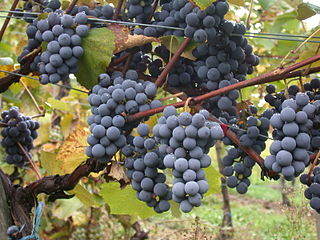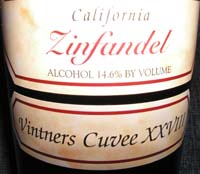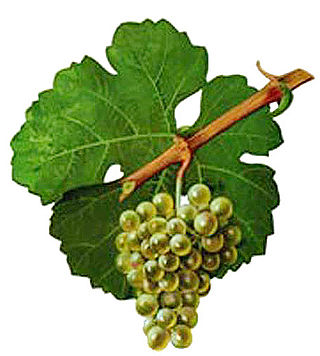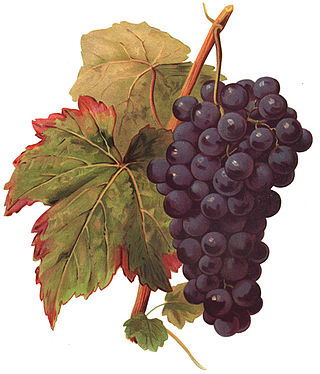Regner is a white German wine grape variety that is a crossing of the table grape Seidentraube and the Vitis vinifera red grape variety Gamay. The variety was developed in 1929 and by 2019 there was almost 12 hectares (30 acres) of Regner planted in Germany, all in the Rheinhessen.

Riesling is a white grape variety that originated in the Rhine region. Riesling is an aromatic grape variety displaying flowery, almost perfumed, aromas as well as high acidity. It is used to make dry, semi-sweet, sweet, and sparkling white wines. Riesling wines are usually varietally pure and are seldom oaked. As of 2004, Riesling was estimated to be the world's 20th most grown variety at 48,700 hectares, but in terms of importance for quality wines, it is usually included in the "top three" white wine varieties together with Chardonnay and Sauvignon blanc. Riesling is a variety that is highly "terroir-expressive", meaning that the character of Riesling wines is greatly influenced by the wine's place of origin.

Pinot noir is a red-wine grape variety of the species Vitis vinifera. The name may also refer to wines created predominantly from pinot noir grapes. The name is derived from the French words for pine and black. The word pine alludes to the grape variety having tightly clustered, pinecone–shaped bunches of fruit.

Ice wine is a type of dessert wine produced from grapes that have been frozen while still on the vine. The sugars and other dissolved solids do not freeze, but the water does, allowing for a more concentrated grape juice to develop. The grapes' must is then pressed from the frozen grapes, resulting in a smaller amount of more concentrated, very sweet juice. With ice wines, the freezing happens before the fermentation, not afterwards. Unlike the grapes from which other dessert wines are made, such as Sauternes, Tokaji, or Trockenbeerenauslese, ice wine grapes should not be affected by Botrytis cinerea or noble rot, at least not to any great degree. Only healthy grapes keep in good shape until the opportunity arises for an ice wine harvest, which in extreme cases can occur after the New Year, on a northern hemisphere calendar. This gives ice wine its characteristic refreshing sweetness balanced by high acidity. When the grapes are free of Botrytis, they are said to come in "clean". This results in a very complex and sweet wine. Much ice wine is made from the grapes Riesling, Vidal, Cabernet Franc and Cabernet Sauvignon, but there is also ice wine made from Shiraz, Merlot, Sangiovese and others.

Gewürztraminer is an aromatic wine grape variety, used in white wines, and performs best in cooler climates. In English, it is sometimes referred to colloquially as Gewürz, and in English and French it is written Gewurztraminer. Gewürztraminer is a variety with a pink to red skin colour, which makes it a "white wine grape" as opposed to the blue to black-skinned varieties commonly referred to as "red wine grapes". The variety has high natural sugar and the wines are white and usually off-dry, with a flamboyant bouquet of lychees. Indeed, Gewürztraminer and lychees share the same aroma compounds. Dry Gewürztraminers may also have aromas of roses, passion fruit and floral notes. It is not uncommon to notice some spritz.

Pinot Meunier, pronounced [pi.no mø.nje], also known as Meunier or Schwarzriesling, is a variety of red wine grape most noted for being one of the three main varieties used in the production of Champagne. Until recently, producers in Champagne generally did not acknowledge Pinot Meunier, preferring to emphasise the use of the other noble varieties, but now Pinot Meunier is gaining recognition for the body and richness it contributes to Champagne. Pinot Meunier is approximately one-third of all the grapes planted in Champagne. It is a chimeric mutation of Pinot: its inner cell layers are composed of a Pinot genotype which is close to Pinot noir or Pinot gris; the outer, epidermal, layer is, however, made up of a mutant, distinctive, genotype. Pinot Meunier was first mentioned in the 16th century, and gets its name and synonyms from flour-like dusty white down on the underside of its leaves.

Gamay is a purple-colored grape variety used to make red wines, most notably grown in Beaujolais and in the Loire Valley around Tours. Its full name is Gamay Noir à Jus Blanc. It is a very old cultivar, mentioned as long ago as the 15th century. It has been often cultivated because it makes for abundant production; however, it can produce wines of distinction when planted on acidic soils, which help to soften the grape's naturally high acidity.

Grüner VeltlinerGerman: [ˈɡʁyːnɐ fɛltˈliːnɐ](listen)) is a white wine grape variety grown primarily in Austria, Hungary, Slovakia, and the Czech Republic. The leaves of the grape vine are five-lobed with bunches that are long but compact, and deep green grapes that ripen in mid-late October in the Northern Hemisphere.

A varietal wine is a wine made primarily from a single named grape variety, and which typically displays the name of that variety on the wine label. Examples of grape varieties commonly used in varietal wines are Cabernet Sauvignon, Chardonnay and Merlot. Wines that display the name of two or more varieties on their label, such as a Chardonnay-Viognier, are blends and not varietal wines. The term is frequently misused in place of vine variety; the term variety refers to the vine or grape, while varietal refers to the wine produced by a variety.

The Muscat family of grapes includes over 200 grape varieties belonging to the Vitis vinifera species that have been used in wine production and as raisin and table grapes around the globe for many centuries. Their colors range from white, to yellow, to pink to near black. Muscat grapes and wines almost always have a pronounced floral aroma. The breadth and number of varieties of Muscat suggest that it is perhaps the oldest domesticated grape variety, and there are theories that most families within the Vitis vinifera grape variety are descended from the Muscat variety.

German wine is primarily produced in the west of Germany, along the river Rhine and its tributaries, with the oldest plantations going back to the Roman era. Approximately 60 percent of German wine is produced in the state of Rhineland-Palatinate, where 6 of the 13 regions (Anbaugebiete) for quality wine are situated. Germany has about 103,000 hectares of vineyard, which is around one tenth of the vineyard surface in Spain, France or Italy. The total wine production is usually around 10 million hectoliters annually, corresponding to 1.3 billion bottles, which places Germany as the eighth-largest wine-producing country in the world. White wine accounts for almost two thirds of the total production.

Müller-Thurgau is a white grape variety which was created by Hermann Müller from the Swiss Canton of Thurgau in 1882 at the Geisenheim Grape Breeding Institute in Germany. It is a crossing of Riesling with Madeleine Royale. It is used to make white wine in Germany, Austria, Northern Italy, Hungary, England, Australia, the Czech Republic, Slovakia, Slovenia, New Zealand, Canada, the United States, Belgium and Japan. There are around 22,201 hectares ) cultivated worldwide, which makes Müller-Thurgau the most widely planted of the so-called "new breeds" of grape varieties created since the late 19th century. Although plantings have decreased significantly since the 1980s, as of 2019 it was still Germany's second most planted variety at 11,400 hectares and 11.4% of the total vineyard surface. In 2007, the 125th anniversary was celebrated at the Geisenheim Grape Breeding Institute. Müller-Thurgau is also known as Rivaner, Riesling x Sylvaner, Riesling-Sylvaner, Rizvanec (Slovenia) and Rizlingszilváni (Hungary).

Sylvaner or Silvaner is a variety of white wine grape grown primarily in Alsace and Germany, where its official name is Grüner Silvaner. While the Alsatian versions have primarily been considered simpler wines, it was included among the varieties that can be used to produce Alsace Grand Cru wine in 2006, together with the four 'noble grapes' of Alsace, although only in one vineyard, Zotzenberg.

Tobias Regner is a German singer and guitarist who has enjoyed success in the rock music genre. He made his debut under major label Sony BMG Domestic after he won the highly publicized third season of the television series Deutschland sucht den Superstar, the German version of Pop Idol, in 2006.

St. Laurent is a highly aromatic dark-skinned wine grape variety. Its origins shrouded in mystery, St. Laurent is believed to have resulted from a crossing of Pinot noir with an unknown second parent. However, current DNA research done at HBLAWO Klosterneuberg in Austria by Dr. Ferdinand Regner has now confirmed the genetic link of St. Laurent to Pinot Noir. A link to a second parent was not able to be confirmed in this research, which led Dr. Regner to conclude that St. Laurent is either a 'selfing' or seedling of Pinot Noir, or it is the result of hybridization with an as yet unidentified second parent. This work confirms that St. Laurent is the direct genetic offspring of Pinot Noir.

Madeleine Angevine is a white wine grape from the Loire Valley in France that is also popular in Germany, Kyrgyzstan and Washington state. The early-ripening grape is a cross between Madeleine Royale and Malingre Précoce grapes that grows well in cooler climates. Madeleine Angevine makes an attractive fruity wine with a flowery nose, similar to an Alsatian Pinot blanc. It is crisp, acid and dry and pairs particularly well with seafoods such as crab and oyster.
The Vitis International Variety Catalogue (VIVC) is a database of various species and varieties/cultivars of grapevine, the genus Vitis. VIVC is administered by the Geilweilerhof Institute for Grape Breeding in Siebeldingen, Germany, and contains information from grapevine collections existing in various institutes of viticulture around the world. As of April 2009, the information in the database brought together information from 130 institutions located in 45 countries, and contains about 18,000 entries.

Luglienga is a white Italian wine and table grape variety that is grown across Europe. The grape has a long history of use, dating back to at least the 14th century in Piedmont but is today most seen a table grape that is occasionally used for home winemaking.

"I Still Burn" is a song by German recording artist Tobias Regner, the winner of the third season of the reality television talent show Deutschland sucht den Superstar, broadcast in 2006. It was written by Jess Cates and Peter Wright and produced by Brix Ingo Politz, and Bernd Wendlandt, marking the first time, a DSDS coronation song was not produced by judge Dieter Bohlen. Released as Regner's debut single on March 24, 2006 in German-speaking Europe, it became the biggest-selling single in two years to debut at the charts, where it reached number one in Austria, Germany, and Switzerland, making him the first DSDS winner to top the charts in all three regions. "I Still Burn" was eventually certified gold by the Bundesverband Musikindustrie (BVMI) and became Germany's 13th best-selling single of 2006. It was later included on Regner's debut album Straight (2006).
Georg Scheu, was a German botanist, plant physiologist, oenologist and grape breeder.
Regner is a German habitational surname composed of the ancient Germanic elements ragin.